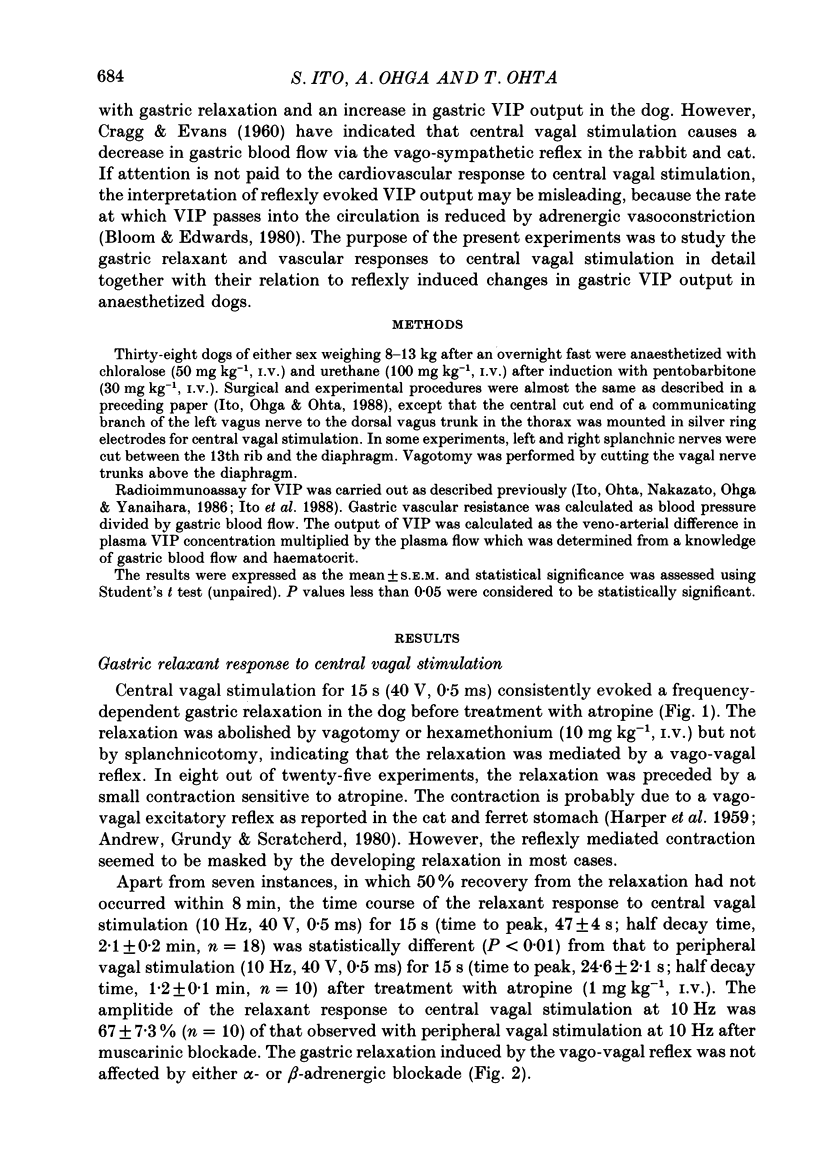Abstract
1. Gastric relaxation, vasodilatation and vasoactive intestinal peptide (VIP) output from the stomach in response to stimulation of the central end of the cut vagus nerve were studied in anaesthetized dogs. 2. Central vagal stimulation (10 Hz, 40 V, 0.5 ms) normally produced a non-adrenergic, non-cholinergic (NANC) gastric relaxation via a vago-vagal reflex. It also caused an increase followed by a decrease in gastric blood flow. 3. The increase in blood flow was attributable to a NANC gastric vasodilatation via a vago-vagal reflex and the subsequent reduction in blood flow was decreased by splanchinicotomy. All these gastric and vascular responses were abolished by hexamethonium. 4. The gastric relaxation and vasodilatation induced by the vago-vagal reflex had similar stimulation frequency-response and pulse duration-response relations. 5. Central vagal stimulation caused an increase in gastric venous VIP output which was abolished by vagotomy or hexamethonium but unaffected by splanchnicotomy. 6. VIP injected into the gastric artery mimicked the gastric relaxant and vasodilator responses to the vago-vagal reflex. 7. We conclude that the intramural NANC inhibitory nerves activated by the vago-vagal reflex release VIP which causes both gastric relaxation and vasodilatation.
Full text
PDF










Selected References
These references are in PubMed. This may not be the complete list of references from this article.
- Abrahamsson H., Jansson G. Elicitation of reflex vagal relaxation of the stomach from pharynx and esophagus in the cat. Acta Physiol Scand. 1969 Sep-Oct;77(1):172–178. doi: 10.1111/j.1748-1716.1969.tb04561.x. [DOI] [PubMed] [Google Scholar]
- Abrahamsson H. Studies on the inhibitory nervous control of gastric motility. Acta Physiol Scand Suppl. 1973;390:1–38. [PubMed] [Google Scholar]
- Andrews P. L., Grundy D., Scratcherd T. Reflex excitation of antral motility induced by gastric distension in the ferret. J Physiol. 1980 Jan;298:79–84. doi: 10.1113/jphysiol.1980.sp013068. [DOI] [PMC free article] [PubMed] [Google Scholar]
- Andrews P. L., Lawes I. N. The role of vagal and intramural inhibitory reflexes in the regulation of intragastric pressure in the ferret. J Physiol. 1982 May;326:435–451. doi: 10.1113/jphysiol.1982.sp014204. [DOI] [PMC free article] [PubMed] [Google Scholar]
- Bloom S. R., Edwards A. V. Effects of autonomic stimulation on the release of vasoactive intestinal peptide from the gastrointestinal tract in the calf. J Physiol. 1980 Feb;299:437–452. doi: 10.1113/jphysiol.1980.sp013135. [DOI] [PMC free article] [PubMed] [Google Scholar]
- CRAGG B. G., EVANS D. H. Some reflexes mediated by the afferent fibers of the abdominal vagus in the rabbit and cat. Exp Neurol. 1960 Feb;2:1–12. doi: 10.1016/0014-4886(60)90043-1. [DOI] [PubMed] [Google Scholar]
- Costa M., Furness J. B. The origins, pathways and terminations of neurons with VIP-like immunoreactivity in the guinea-pig small intestine. Neuroscience. 1983 Apr;8(4):665–676. doi: 10.1016/0306-4522(83)90002-7. [DOI] [PubMed] [Google Scholar]
- Davies J. M., Williams K. I. Endothelial-dependent relaxant effects of vaso-active intestinal polypeptide and arachidonic acid in rat aortic strips. Prostaglandins. 1984 Feb;27(2):195–202. doi: 10.1016/0090-6980(84)90073-x. [DOI] [PubMed] [Google Scholar]
- Fahrenkrug J., Haglund U., Jodal M., Lundgren O., Olbe L., de Muckadell O. B. Nervous release of vasoactive intestinal polypeptide in the gastrointestinal tract of cats: possible physiological implications. J Physiol. 1978 Nov;284:291–305. doi: 10.1113/jphysiol.1978.sp012541. [DOI] [PMC free article] [PubMed] [Google Scholar]
- HARPER A. A., KIDD C., SCRATCHERD T. Vago-vagal reflex effects on gastric and pancreatic secretion and gastrointestinal motility. J Physiol. 1959 Oct;148:417–436. doi: 10.1113/jphysiol.1959.sp006297. [DOI] [PMC free article] [PubMed] [Google Scholar]
- Ignarro L. J., Byrns R. E., Buga G. M., Wood K. S. Mechanisms of endothelium-dependent vascular smooth muscle relaxation elicited by bradykinin and VIP. Am J Physiol. 1987 Nov;253(5 Pt 2):H1074–H1082. doi: 10.1152/ajpheart.1987.253.5.H1074. [DOI] [PubMed] [Google Scholar]
- Ito S., Ohga A., Ohta T. Gastric vasodilatation and vasoactive intestinal peptide output in response to vagal stimulation in the dog. J Physiol. 1988 Oct;404:669–682. doi: 10.1113/jphysiol.1988.sp017312. [DOI] [PMC free article] [PubMed] [Google Scholar]
- Ito S., Ohta T., Nakazato Y., Ohga A., Yanaihara N. Effects of avian pancreatic peptide on smooth muscle relaxations by vasoactive intestinal peptide and inhibitory nerve stimulation. Jpn J Pharmacol. 1986 Mar;40(3):423–434. doi: 10.1254/jjp.40.423. [DOI] [PubMed] [Google Scholar]
- Ohga A., Nakazato Y., Saito K. An analysis of the vago-vagal reflex relaxation of the stomach. Nihon Seirigaku Zasshi. 1969;31(2):92–93. [PubMed] [Google Scholar]
- Ohga A., Nakazato Y., Saito K. Considerations of the efferent nervous mechanism of the vago-vagal reflex relaxation of the stomach in the dog. Jpn J Pharmacol. 1970 Mar;20(1):116–130. doi: 10.1254/jjp.20.116. [DOI] [PubMed] [Google Scholar]
- Ohta T., Nakazato Y., Ohga A. Reflex control of the gastric motility by the vagus and splanchnic nerves in the guinea pig in vivo. J Auton Nerv Syst. 1985 Oct;14(2):137–149. doi: 10.1016/0165-1838(85)90071-2. [DOI] [PubMed] [Google Scholar]


